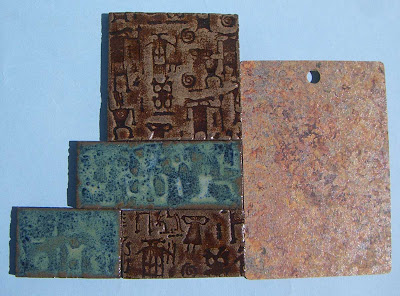Lots of things going on over here in my studio.
The backsplash project has been delayed a few days, while I juggle my schedule and wait for some materials. I used part of the time to go exterior door shopping with another client. I'll be installing his door next weekend, if all goes as planned. Going door shopping could send me on a huge rant about the employees at two local big box hardware stores. You know the ones, you have them in your town, too.
My two stores might have the LEAST helpful employees of all time. You know how you see badges on some employees, when they win some sort of award for attendence or whatever the hell they supposedly do? Well, the workers at our local stores should have to wear badges that say "I am from Planet Dork."
Hell, I'll make the badges for them.

And I have an upcoming post from a guest blogger who has been kind enough to allow me to write about his current project - building a set of Tage Frid's stools. I think Frid's stools are not only challenging, but force the maker to think outside the box. He's sent some great pictures of his progress, and written about his process; it'll be an interesting post, so stay tuned.
Meanwhile, Autumn in Las Vegas is pure heaven. The summers can be brutal, but the weather we've been having lately is the reason we moved here. It's gorgeous and really makes me thankful that we took the plunge and moved across country. While my friends and family have been telling me about snow showers back east, I'm still gardening and wondering when I'll have to pull out some of the veggie plants.
The backsplash project has been delayed a few days, while I juggle my schedule and wait for some materials. I used part of the time to go exterior door shopping with another client. I'll be installing his door next weekend, if all goes as planned. Going door shopping could send me on a huge rant about the employees at two local big box hardware stores. You know the ones, you have them in your town, too.
My two stores might have the LEAST helpful employees of all time. You know how you see badges on some employees, when they win some sort of award for attendence or whatever the hell they supposedly do? Well, the workers at our local stores should have to wear badges that say "I am from Planet Dork."
Hell, I'll make the badges for them.

And I have an upcoming post from a guest blogger who has been kind enough to allow me to write about his current project - building a set of Tage Frid's stools. I think Frid's stools are not only challenging, but force the maker to think outside the box. He's sent some great pictures of his progress, and written about his process; it'll be an interesting post, so stay tuned.
Meanwhile, Autumn in Las Vegas is pure heaven. The summers can be brutal, but the weather we've been having lately is the reason we moved here. It's gorgeous and really makes me thankful that we took the plunge and moved across country. While my friends and family have been telling me about snow showers back east, I'm still gardening and wondering when I'll have to pull out some of the veggie plants.

The basil has gone to seed. Last year, I pulled all the leaves, washed and froze them in baggies for the winter. By the time Spring came around, I still had a few bags left, so I'll probably not put away so many this year.
 The peppers continue to insanely grow, I have one plant that's so weighted down, it's growing like a vine on the gravel. The plant below is about 5' tall, it's reminds me of the Jack in the Beanstalk book.
The peppers continue to insanely grow, I have one plant that's so weighted down, it's growing like a vine on the gravel. The plant below is about 5' tall, it's reminds me of the Jack in the Beanstalk book. 
















































